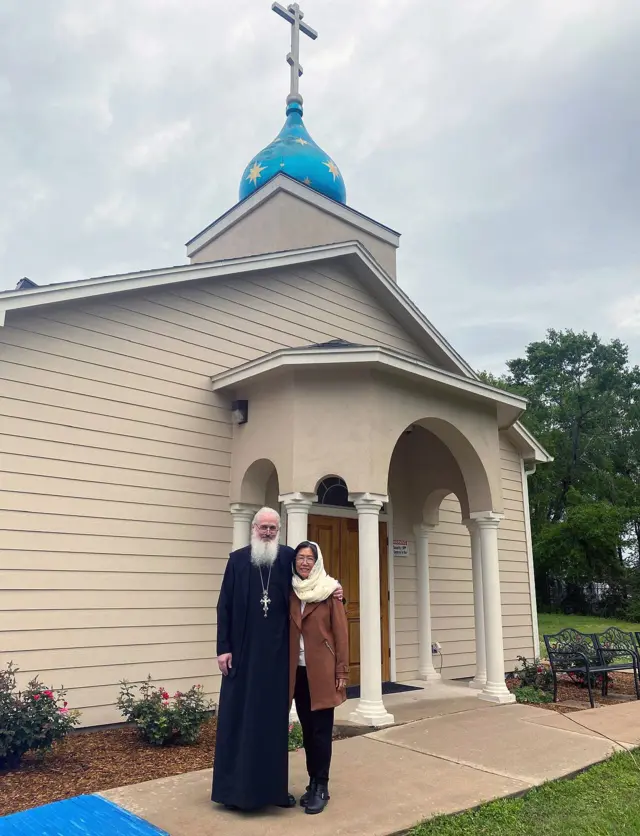Young American Men Turn to Russian Orthodox Churches for Traditional Masculinity
A growing number of young men in the United States are seeking solace and identity in Russian Orthodox churches, drawn by a message of unabashed masculinity promoted by leaders like Father Moses McPherson. His congregation in Georgetown, Texas, has witnessed a remarkable tripling in size over the past 18 months, reflecting a notable trend among men searching for deeper meaning in their lives.
In various online videos, Father Moses discusses what he refers to as “absurd levels of manliness,” rejecting modern societal norms that he perceives as overly feminized. He chastises common behaviors, such as wearing skinny jeans or crossing one’s legs, as unmanly, promoting a robust image of masculinity instead. This is embodied in his personal routine of weightlifting while listening to heavy metal music.
A Shift in Faith
Father Moses, once a Protestant and former roofer, now leads the Russian Orthodox Church Outside Russia (ROCOR), a tradition that draws on centuries of Orthodox faith. This branch, with roots tracing back to the early 20th century, has been steadily gaining adherents in the U.S., particularly among those disenchanted with liberal values. In the past six months alone, he has facilitated the baptism of 75 new members at his church, known as the Mother of God.
Among the new congregants is Theodore, a software engineer who had long rejected religious beliefs yet found a profound emptiness in his life. He embodies a sentiment shared among many young men—feelings of systematic criticism and societal expectations that seemingly undermine traditional roles of masculinity. “Men want to provide for their families; being labeled toxic for it is disheartening,” he states.
Emphasis on Tradition
Many of the church’s new members have chosen to homeschool their children, reflecting a deep commitment to traditional values. Father John Whiteford, an archpriest from near Houston, emphasizes that home-schooling provides both a religious foundation and safeguards children from modern discussions on topics like gender identity.
The appeal of Orthodox Christianity, despite its small stature in the U.S. compared to evangelical megachurches, lies in its promise of conservative values amidst a rapidly evolving cultural landscape. Recent statistics indicate a significant demographic shift within the Orthodox Church, with men making up approximately 64% of congregants, a rise from 46% in 2007.
Digital Influence and Community
Father Moses’s strong online presence plays a significant role in attracting new followers. His social media posts often resonate with thousands, while other clergy in the Orthodox faith also utilize platforms to reach a wider audience of men eager for a community that reflects their values. This digital dimension of faith has been crucial for many seeking a path during the isolating years of the pandemic.
A Broader Conversation
Interestingly, this surge in interest is not free from controversy. Skeptics within and outside the community have noted that many new converts embrace a view of Orthodoxy that is heavily influenced by their perceptions of masculinity and authority. Critics argue that this can skew the original intent and teachings of the faith.
Buck Johnson, a firefighter and podcaster, reflects how he was initially apprehensive about joining a church due to his appearance but was welcomed warmly. He admits that the community’s perception of Russia contrasts sharply with mainstream media narratives, often depicting the nation as a moral bastion amidst perceived Western decline.
Summary of Trends in US Orthodox Churches
| Aspect | Details |
|---|---|
| Current Growth | Congregation numbers have tripled in 18 months. |
| Demographics | Men now constitute 64% of Orthodox congregants, up from 46% in 2007. |
| Reasons for Conversion | Desire for traditional values and disillusionment with modern society. |
As young men navigate societal challenges, the Russian Orthodox Church presents an appealing alternative that resonates with their search for identity and purpose. By intertwining faith with a vision of traditional masculinity, these communities are reshaping the landscape of spirituality in America.




